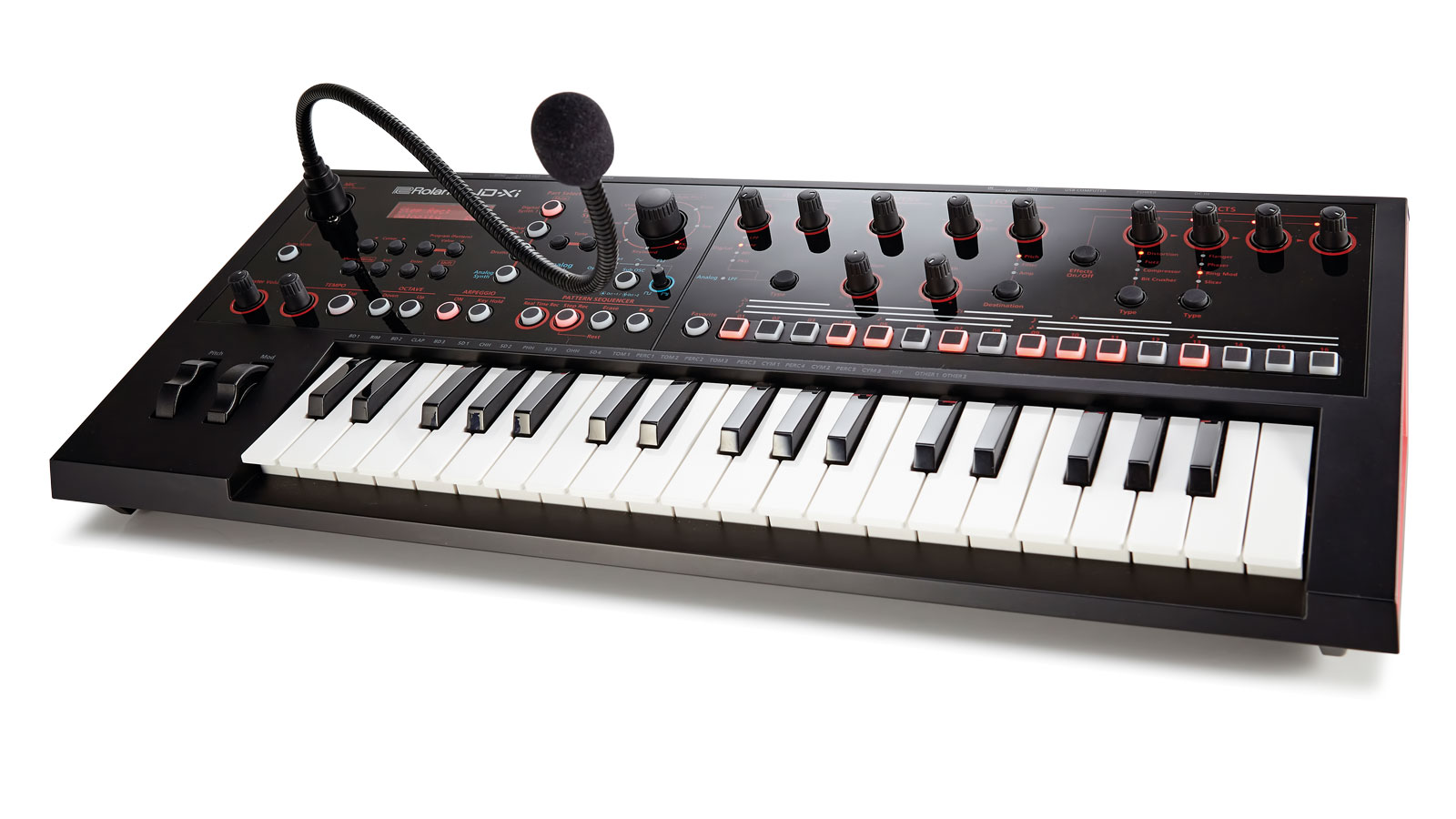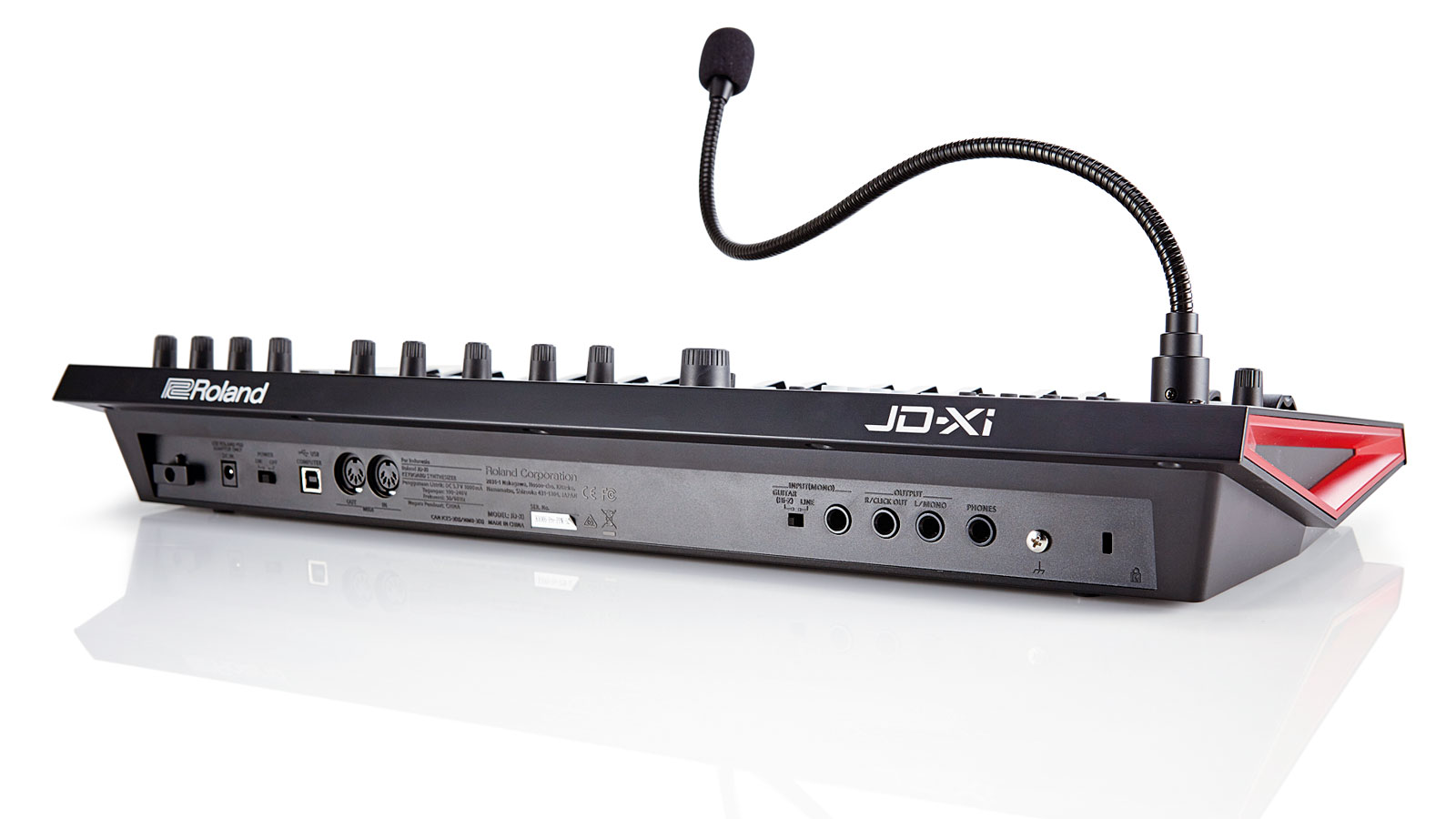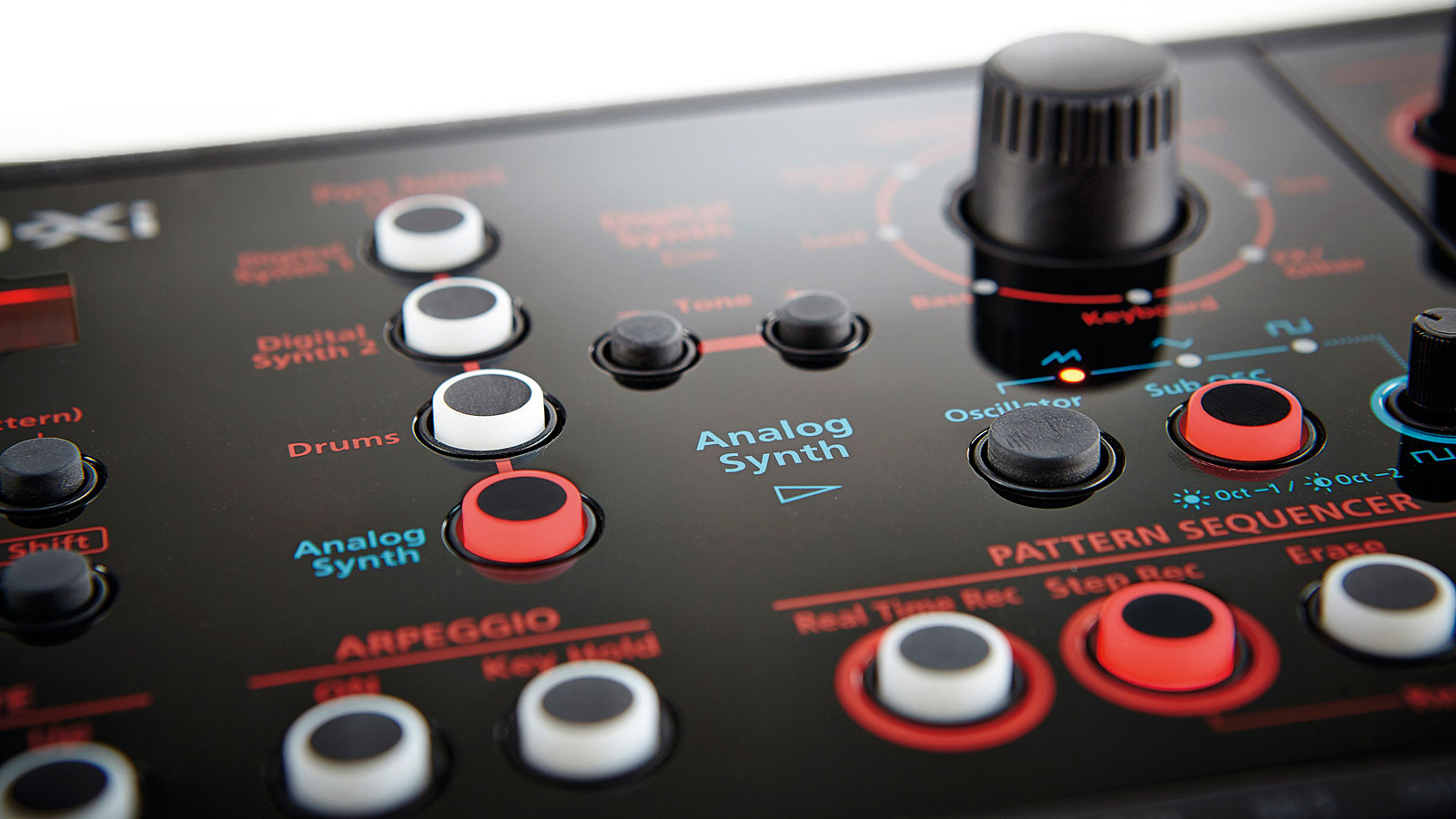MusicRadar Verdict
The JD-Xi's feature-set, versatility and sound quality are unrivalled at this price point. What's not to like!
Pros
- +
The real analogue monosynth sounds great, whilst the SuperNatural engine is deep and extremely versatile. The four-part onboard sequencer is an inspiring live and studio tool. The vocoder and effects, plus audio interface capability round things off nicely.
Cons
- -
You can't route digital parts through the analogue filter. This much functionality means a fair amount of menu diving.
MusicRadar's got your back

Roland JD-Xi

Rear

Buttons
Everyone has been lamenting the lack of a Roland analogue synth for years but, with real analogue having such a resurgence currently, Roland simply couldn't afford to sit out of this market any longer. The new JD-Xi is Roland's first 'crossover' synth fusing Roland's respected SuperNatural technology to an all-new analogue synth engine.
The JD-Xi looks classy, taking many design cues from the FA line. Like the FA, the colour scheme is black and red with a glossy front panel but the JD-Xi also features striking metallic red plastic sides.
"Round the back there's USB for DAW connection and the JD-Xi acts as a 16-bit/44kHz 2in/2out USB Audio/MIDI interface"
The panel features 15 sturdy-feeling knobs that send/receive MIDI, plus translucent rubber backlit selector buttons and it all feels well built. The red LCD is easy to read and relays the plethora of onboard parameters well considering its small size.
However, with so many functions/parameters hidden in menus, there's inevitably a lot of cursor/button pressing so we hope the rumours of an editor in the works come true.
Thankfully, you can scroll in tens and jump straight to editing sections when holding shift plus pressing the incremental buttons, but perhaps Roland can add an alternative value dial mode for the tempo knob in an update.
Take a gander
Front left you'll find mini pitch/mod wheels that feel smooth and work well, whilst the velocity sensitive four-octave mini-key keyboard feels nicely balanced and fast. There's no aftertouch included but the JD-Xi responds to incoming aftertouch.
Physically, the footprint is similar to Korg's microKorg and Novation's MiniNova, and similarly there's a large category dial for selecting sound types and an XLR gooseneck mic socket (with a nice bendy gooseneck mic included) for vocoding and MiniNova-like vocal tuning duties.
Physical downsides are that there's no rear gain control (mic gain is in the menus), some straplocks would have been great (to enable you to strap on the JD-Xi keytar/DX100-style!) and there's no battery power option.
Round the back there's USB for DAW connection and the JD-Xi acts as a 16-bit/44kHz 2in/2out USB Audio/MIDI interface. Then there's two 1/4-inch jack outs (one of which can send out the sequencer click for gigs), plus a headphone out and a mono input which can be switched between Hi-Z/line level.
You can plug in an instrument or MP3 player here and also use any audio source to trigger the vocoder and the monophonic Autopitch/note function.
Autopitch/note corrects badly sung audio according to a user-selected scale (automatically or via the keyboard) but, as any incoming audio can trigger Autopitch/note too, you can use your voice to record notes into the sequencer and also use the JD-Xi as a guitar synth where you use your guitar/bass to trigger the digital oscillators.
It tracks guitar audio very well, though we advise using a gate pedal so string noise doesn't inadvertently trigger the oscs.
SuperNatural sounds
Now the sound engine(s)! The JD-Xi is four-part multitimbral - two digital parts, a drum part and a monophonic analogue part all outputting/receiving on separate MIDI channels (1, 2, 10 and 3 respectively) and each part has a corresponding sequencer track.
There are 256 digital presets, 64 analogue presets and 32 drum kits onboard with 256 user spaces.
"The analogue engine sounds classy and modern, yet unmistakably Roland-y"
The digital parts are each 64-note polyphonic (making the microKorg XL's eight-note and MiniNova's 18-note polyphony seem antiquated!) and the JD-Xi surprisingly houses a full-blown Roland SuperNatural synth engine with an editing depth almost equal to the FA and Integra 7/Jupiter series which is big news at this price point!
The sound quality is just about up there with Roland's more expensive product lines and the character is similarly warm, hi-fi and engaging.
Each of the digital parts is very powerful and within a Program you can have a tone with three partials, so you can layer a PCM piano, plus SuperNatural strings and brass (for example) per digital part.
Admittedly there aren't the complex multi-sampled piano sounds or keyboard split sounds that you'll find on the FA /Jupiter series, but the included sounds/sequences are decent (very Dance orientated) and the PCM samples very usable, plus you can add more from the Axial library.
There's more than enough tweakability to keep avid programmers happy including editable amp/filter envelopes, an A/D pitch envelope, several great sounding digital filters, a separate modulation and general purpose LFO per partial with fade, key trigger and more (and the list goes on). This is luxury for a sub £500 synth!
Due to the small form factor, only a few real-time knobs are present but Roland has chosen them wisely with controls for filter, pulse width, LFO (with three destinations), effect/amp levels and a clever continuously variable amp envelope dial that gives you short decays/long releases to the left, punchy sounds in the middle and slow attacks/ longer releases to the right. The envelopes are nicely snappy too.
The versatile drum part allows kits with two sounds per key (with labels for drum type above each key). The beauty here is you can have different filter, envelope, volume, effect, pan and pitch levels per key.
The preset kits include authentic samples of Roland's classic drum machines and more, including various noises, percussion sounds and vocal samples, whilst the 453 onboard drum waves are very good quality.
Now the analogue part! The Roland boffins have informed us that there's "one DCO analogue oscillator (plus Sub Osc), one TVF analogue filter (LPF) and one TVA analogue amplifier (similar structure as Juno-60, 106, Alpha Juno/JX-3P/JX-8P/JX-10), whilst the envelopes and LFOs are digital".
Importantly, the analogue engine sounds classy and modern, yet unmistakably Roland-y, which bodes extremely well for the upcoming JD-XA poly.
"The JD-Xi's feature set, versatility and sound quality are wholly unrivalled at this price"
You can hear some stepping when turning the filter cutoff slowly (though only at extreme high resonance settings) but the saw, triangle and variable pulse waves are rich, full and punchy and the general character is precise, warm and present (even rivalling the quality of some more expensive analogue monos) - the JD-Xi certainly reminds us of an old Juno-106 sonically, which is a good thing too.
Also, you can't detune the main analogue osc against the sub oscillator but there's PWM available via the LFO for adding movement/detuning.
The ladder-based analogue LPF sounds great and can produce speaker-shaking subs, refined lows, juicy squelches and sizzling highs. Like the digital and drum parts, the analogue part can be routed through the effects and it's a godsend having everything so fully self-contained for gigging.
The main downside is that you can't route the digital parts through the analogue filter or layer them with the analogue synth except when sequencing; but still, when you add in the sequencer and audio/MIDI interface you realise that the JD-Xi is surely the most fully featured synth in the sub £500 bracket.
The JD-Xi has just turned the synth world upside down! It has just about everything live performers, beat makers, analogue heads and studio producers desire for very little outlay in a sturdy and portable form factor.
Although there are minor downsides, most are likely tweakable in OS updates and the bottom line is that the JD-Xi's feature set, versatility and sound quality are wholly unrivalled at this price.
The JD-Xi is inspiring to perform and compose with, all the basic controls you need for live/studio tweaking are onboard and the 'crossover' concept is ingenious. Roland surely has a hit on their hands - now bring on the JD-XA!
“Excels at unique modulated timbres, atonal drones and microtonal sequences that reinvent themselves each time you dare to touch the synth”: Soma Laboratories Lyra-4 review
“I used everything I knew about music”: How Green Day exceeded expectations with their most ambitious song
YouTube just added AI tools that makes musicians, library music and video editors redundant









